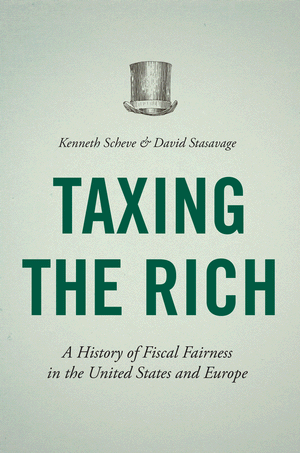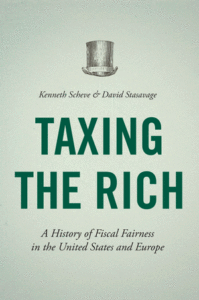
Taxing the Rich: A History of Fiscal Fairness in the United States and Europe by Kenneth Scheve and David Stasavage

In the post-Piketty world, economic inequality has returned to the top of the agenda of political economists with a vengeance. A flurry of research projects has started to investigate the sources and the consequences of growing disparities between the rich and the poor. These projects are not just driven by analytical motivations. Researchers are also looking for political strategies to reduce inequality. This impetus is well captured in the title of Anthony Atkinson’s recent book: Inequality. What Can Be Done?
One of the most prominent answers to this question, suggested by both Piketty and Atkinson, is a call for higher taxes on the rich. As economists have started to demonstrate, higher taxes at the top are not necessarily harmful to the economy, and may thus well be feasible in economic terms. The politics of steeply progressive taxation may be an entirely different matter though. Political scientists will thus ask under which conditions these taxes win political support.
This is where Kenneth Scheve’s and David Stasavage’s fascinating new book Taxing the Rich comes in. As has been well documented, taxes on the rich in industrialized countries were increased heavily in the first half of the twentieth century before they started a lasting decline since the 1970s. Scheve and Stasavage ask how this trajectory can be explained. Their answer is that wars of mass mobilization, most notably World War I and World War II, enabled proponents of progressive taxes to make compensatory arguments that resonated with political majorities.
Their answer is that wars of mass mobilization, most notably World War I and World War II, enabled proponents of progressive taxes to make compensatory arguments that resonated with political majorities.
The “conscription of labor” into mass infantries was thus complemented by a “conscription of wealth.” When the memory of these wars started to fade, however, supporters of progressive taxation where increasingly put on the defensive. The rise and fall of progressive taxes was thus closely related to the incidence of mass warfare. By contrast, Scheve and Stasavage find little evidence that high taxes on the rich were an effect of democratization (in a Meltzer/Richard fashion) or a thermostatic response to growing inequality (as might be predicted by optimistic readings of Polanyi’s double movement).
The book starts with a theoretical discussion of different concepts of fairness in taxation, most prominently the “ability to pay doctrine,” on the one hand, and what Scheve and Stasavage call the “compensatory theory,” on the other hand. Ability to pay is the classical argument that equality of sacrifice among taxpayers requires a progressive tax schedule because of the declining marginal utility of income. The compensatory theory, by contrast, suggests that progressive taxes compensate for some unfair advantage bestowed upon the rich by the state.
Scheve’s and Stasavage’s main empirical claim is that compensatory arguments, not ability to pay, were the political drivers behind the increase of progressive taxes in the first half of the twentieth century. To succeed, however, these compensatory arguments needed specific circumstances: people will see taxes as rightful compensation for existing inequalities only if they believe that the state played a role in generating these inequalities. The most important sources of such government-created inequities were wars of mass mobilization.
Scheve and Stasavage support this claim in two steps. First, the second part of the book looks at the development of top income tax and inheritance tax rates in a macro-comparative perspective. Based on an impressive data collection effort, the authors extend results from earlier articles (Scheve/Stasavage 2010, Scheve/Stasavage 2012) to demonstrate the strong and significant effect of warfare on tax rates. This analysis mainly relies on a difference-in-difference logic: Compared to non-participants, belligerent countries increased their tax rates much more strongly, whereas there was no discernable difference in trends before these wars.
This analysis mainly relies on a difference-in-difference logic: Compared to non-participants, belligerent countries increased their tax rates much more strongly, whereas there was no discernable difference in trends before these wars.
This logic is heavily stressed in the presentation: To the benefit of the reader, regression tables are completely banished to an online appendix. Instead, the presentation relies on graphics to demonstrate the main points. Arguably the most impressive visualization of their argument is a graph that compares the development of top income taxes in mobilizing and non-mobilizing countries before, during, and after World War I (81). That said, it is not quite clear why the empirical presentation focuses so strongly on World War I. The authors emphasize its exogeneity—no country selected into this war based on its fiscal capacity—but this reviewer is hardly concerned about the exogeneity of World War II in this regard either.
After having empirically demonstrated that mobilization for mass warfare had a strong effect on progressive taxation, the third part of the book analyzes in greater detail why this was the case. To this end, Scheve and Stasavage look more closely at the politics of tax reform in individual countries. They summarize debates about progressive taxation in the UK, Canada, USA, and France and show that compensatory arguments indeed played an important role during and after major wars. For example, they find that only 6 percent of the speeches about income tax reform in the British parliament made compensatory arguments in the period before World War I, whereas this number rose to 62 percent after World War I began. This evidence is necessarily less systematic than the macro-comparative evidence of the second part of the book. Still, it is a valuable and broadly convincing attempt to get at the mechanisms underlying the macro-correlations.
The fourth part of the book summarizes the results and draws conclusions for current policy debates. Based on their results, Scheve and Stasavage are skeptical regarding the chances for a return of the very high tax rates of the postwar decades. If the ability-to-pay doctrine did not carry the day in the twentieth century, it is unlikely to do so in the twenty-first century. And proponents of progressive taxation will—hopefully—not be able to invoke compensatory claims based on the burdens of mass warfare either. Nevertheless, the authors see some room for compensatory arguments even in a world without mass warfare. If policy entrepreneurs are able to point at other inequities generated by state action, they might be able to win support for at least moderate increases of top tax rates.
Taken together, the book makes a compelling theoretical argument and musters impressive empirical evidence in its support. Moreover, one of its great strengths is its discussion of the validity and robustness of this evidence. The authors do an excellent job of dealing with several potential criticisms. For example, they go at great lengths to demonstrate that their dependent variable, the top tax rate, indeed captures the progressivity of the tax system. In order to do so, they look at the correlation between statutory tax rates and effective tax rates at the top, as well as at the full schedule of income tax rates in six countries for which they have data. Regarding the interpretation of their independent variable, they demonstrate that taxes on the rich were not just a functional necessity of financing the war, thereby ruling out a competing mechanism to the compensatory theory. In addition, they also show that the occurrence of mass warfare was neither random nor endogenous but was itself a function of the prevailing military technologies. Finally, to show that compensatory claims are indeed relevant to how people think about taxation, they conducted a survey in which people were asked to explain their choice between a proportional and a progressive tax scheme.
All these extensions contribute to the persuasiveness of the results. Nevertheless, there remain some open questions. In general, Scheve and Stasavage seem to dismiss the democracy argument a bit too easily. While they convincingly show that the introduction of democracy did not have an immediate effect on top tax rates, they can hardly refute the idea that democracy is a necessary (though not sufficient) condition for the occurrence of high taxes on the rich. In fact, the authors themselves find that taxes increased much more in democratic countries in World War I. Austria and Germany, by contrast, only increased their taxes after the war was over and they had democratized.
Another weakness is that the book too easily generalizes the Anglo-Saxon war experience to all belligerent countries. One could argue that the empirical results are, to a large part, driven by five countries: Great Britain, the United States, Canada, Australia, and New Zealand. By contrast, continental European countries increased their tax rates much less or lowered them again pretty soon after the war was over. This point would have deserved further elaboration in the book. After all, the obvious difference between these groups of countries is that the former sent soldiers into a war abroad, whereas the latter experienced the war on their own territory. This difference can have two interpretations. Firstly, it may simply have been more difficult to make compensatory claims in countries where civilians also suffered heavily from the war. Or, secondly, other considerations may have played a bigger role in these countries because the tax system was needed in order to support reconstruction (for a more thorough analysis of this point, see Haffert 2016).
Despite these caveats, Scheve and Stasavage’s book could hardly be timelier. They have gathered an impressive set of data and have made great use of this effort in their analysis. While ostensibly about the effects of mass warfare, their results have a much deeper importance for our understanding of the politics of taxation and redistribution. It would be mistaken to read their book as just another nail in the already firmly shut coffin of Meltzer/Richard-type arguments. To me, the real importance of their findings for a world without mass warfare is that the interpretation of economic outcomes like inequality depends on how these outcomes came about. For proponents of redistribution, it is not enough to argue that inequality is “too big;” they need to show that the process which created these inequalities was unfair. In this sense, the book can be read as calling for a re-orientation of the discourse about inequality: away from a focus on outcomes and towards a focus on processes. It is hoped that it finds a wide readership among both researchers and political practitioners.
Reviewed by Lukas Haffert, University of Zurich
Taxing the Rich: A History of Fiscal Fairness in the United States and Europe
by Kenneth Scheve and David Stasavage
Princeton University Press
Hardcover / 288 pages / 2016
ISBN: 9781400880379
To read more book reviews, please click here.
References
Atkinson, Anthony, 2015: Inequality. What Can Be Done? Cambridge: Harvard University Press.
Haffert, Lukas, 2016: War mobilization or war destruction? The unequal rise of progressive taxation revisited. Paper prepared for the APSA Annual Meeting. Philadelphia.
Published on December 1, 2016.




